
loading




| Quantity: | |
| Place of Origin | CHINA |
|---|---|
| Brand Name | RPS-SONIC |
| Certification | CE |
| Model Number | RPS-M20 |
| Minimum Order Quantity | 1SET |
| Price | negotiation |
| Packaging Details | FOAM AND CARTON |
| Delivery Time | 3DAYS |
| Payment Terms | T/T, Western Union, MoneyGram, PAYPAL |
| Supply Ability | 500 SETS PER MONTH |
| Name | Ultrasonic Drilling Machine | Frequency | 20Khz |
|---|---|---|---|
| Power | 100w | Type | Hardness Material Drilling |
| Weight | 0.7kg | PL | Transducer With Generator |
| High Light | ultrasonic machining products,ultrasonic drilling machine | ||
Descripersion
The Ultrasonic drilling is a drilling device that uses vibrations in order to hammer its bit through materials, as opposed to traditional drilling methods. The drill uses a piezoelectric actuator as its source of power, and utilizes a variety of 'horns' to vibrate, or hammer, its bit through the material. prototype of the drill was first released by NASA in April 2000, which weighed 1.5 lb. (.7 kg) and had the capacity to drill half-inch holes into granite using only 10 watts of power, whereas the modern household half-inch drill requires 750 watts. The USDC was originally designed to be able to drill through very rigid rock surfaces that would otherwise be damaged by a rotary drill, but has also shown potential usefulness to the field of medicine. It is the specific characteristics of the drill that make it ideal or practical for certain situations.
How it works
The ultrasonic drilling is driven by a Piezoelectric stack actuator that creates the vibrations. The actuator vibrates at an extremely high frequency, making it ultrasonic, and it is these waves of vibration that are transmitted by the horn of the actuator all the way to the bit itself. The vibrations are created at the actuator and are transferred by the horn to a free mass. The free mass vibrates between the drill stem and the horn of the actuator to transmit the vibrations down the drill stem. The drill stem houses the drill bit, and the vibrations push the bit into the material. The repetitive impact on the drill stem by the free mass, creates stress pulses that transmit to the tip of the bit and into the rock. Ultimately, the repetitive strike of the bit produces enough strain on the surface to fracture it.
Horn structures
There are four primary styles of horns, those being:
conical-straight horn - a cone shaped horn coming to a cylindrical point
conical horn - a cone shaped horn, but not coming to a point
step horn - two stacked cylinders, the second being smaller than the first
exponential horn -a cone shaped horn that comes to a point
| ITEM | PARAMETER |
| Frequency | 20Khz |
| Power | 100W |
| Amplitude | 1-5um |
| Dameter | 40MM |
Application:
Use for the ultrasonic drilling has been foreseen in the medical field, for delicate surgeries or procedures involving the human skeletal structure. Operations involving the heart cannot involve high force, which could damage the organ or surrounding rib cage. The ultrasonic’s low axial load ensures that little to no damage would be done to these fragile areas. The drill has also seen possibilities to excavate wire leads for pacemakers
Overall, the ultrasonic drilling requires little power to operate. The ultrasonic drilling requires a very low axial load, or downward force applied, to be able to drill through tough surfaces such as granite, rock, or ice. Near zero torque is needed to operate the drill, as it does not bore using a traditional rotary force. Comparatively, the ultrasonic drilling uses much less power to operate than other drill boring through hard surfaces.

| Name | Ultrasonic Drilling Machine | Frequency | 20Khz |
|---|---|---|---|
| Power | 100w | Type | Hardness Material Drilling |
| Weight | 0.7kg | PL | Transducer With Generator |
| High Light | ultrasonic machining products,ultrasonic drilling machine | ||
Descripersion
The Ultrasonic drilling is a drilling device that uses vibrations in order to hammer its bit through materials, as opposed to traditional drilling methods. The drill uses a piezoelectric actuator as its source of power, and utilizes a variety of 'horns' to vibrate, or hammer, its bit through the material. prototype of the drill was first released by NASA in April 2000, which weighed 1.5 lb. (.7 kg) and had the capacity to drill half-inch holes into granite using only 10 watts of power, whereas the modern household half-inch drill requires 750 watts. The USDC was originally designed to be able to drill through very rigid rock surfaces that would otherwise be damaged by a rotary drill, but has also shown potential usefulness to the field of medicine. It is the specific characteristics of the drill that make it ideal or practical for certain situations.
How it works
The ultrasonic drilling is driven by a Piezoelectric stack actuator that creates the vibrations. The actuator vibrates at an extremely high frequency, making it ultrasonic, and it is these waves of vibration that are transmitted by the horn of the actuator all the way to the bit itself. The vibrations are created at the actuator and are transferred by the horn to a free mass. The free mass vibrates between the drill stem and the horn of the actuator to transmit the vibrations down the drill stem. The drill stem houses the drill bit, and the vibrations push the bit into the material. The repetitive impact on the drill stem by the free mass, creates stress pulses that transmit to the tip of the bit and into the rock. Ultimately, the repetitive strike of the bit produces enough strain on the surface to fracture it.
Horn structures
There are four primary styles of horns, those being:
conical-straight horn - a cone shaped horn coming to a cylindrical point
conical horn - a cone shaped horn, but not coming to a point
step horn - two stacked cylinders, the second being smaller than the first
exponential horn -a cone shaped horn that comes to a point
| ITEM | PARAMETER |
| Frequency | 20Khz |
| Power | 100W |
| Amplitude | 1-5um |
| Dameter | 40MM |
Application:
Use for the ultrasonic drilling has been foreseen in the medical field, for delicate surgeries or procedures involving the human skeletal structure. Operations involving the heart cannot involve high force, which could damage the organ or surrounding rib cage. The ultrasonic’s low axial load ensures that little to no damage would be done to these fragile areas. The drill has also seen possibilities to excavate wire leads for pacemakers
Overall, the ultrasonic drilling requires little power to operate. The ultrasonic drilling requires a very low axial load, or downward force applied, to be able to drill through tough surfaces such as granite, rock, or ice. Near zero torque is needed to operate the drill, as it does not bore using a traditional rotary force. Comparatively, the ultrasonic drilling uses much less power to operate than other drill boring through hard surfaces.









Ultrasonic Welding Equipment Ultrasonic Welding Transducer Ultrasonic Welding Converter Ultrasonic Liquid Processor Ultrasonic Cutting Equipment Ultrasonic Spray Nozzles Ultrasonic Power Supply Ultrasonic Soldering Equipment Ultrasonic Welding Horn Ultrasonic Assisted Machining Ultrasonic Testing Equipment
content is empty!